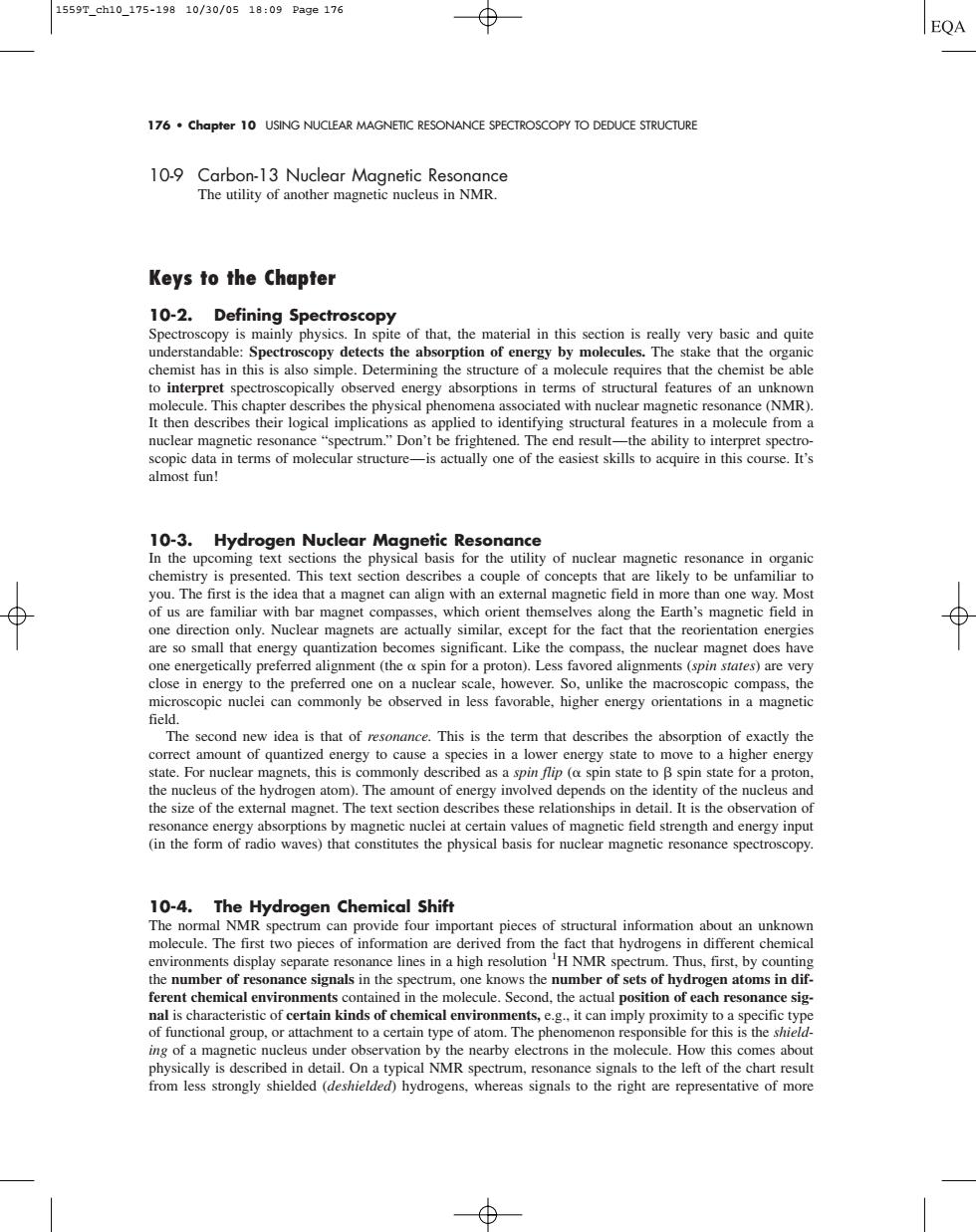正在加载图片...

1559T_ch10_175-19810/30/0518:09Pa9e176 ⊕ EQA 176.chapter 10 USING NUCLEAR MAGNETIC RESONANCE SPECTROSCOPY TO DEDUCE STRUCTURE 10-9 Corbon-13 Nuclear Reso tility of another magnet Keys to the Chapter 10-2.Defining Spectroscopy to interpret spectroscopically observed energy absorptions in terms of structural features of an unkno nuclear magnetic resonance"spectrum.Don't be frightened.The end result-the ability to interpret spectro This text section describes a couple of concepts that st is the that a magnet can algn an e nt th than one one direction only.Nuclear magnets are actually similar,except for the fact that the are so small th ergy qua ntization become the compass the nuclear magnet does have close in enerav microscopic nuclei can commonly be observed in less favorable,higher cnergy orientations in a magnetic The second new idea is that of resonance.This is the term that describes the absorption of exactly the correct amount of quantized nergy to cause a species in a lowe r energy state to move to a higher energy tate.For nuc (spin state to B spin state or a pro r magnetic resonance spectroscopy 10-4 The emical Shift ce lines in a high resolutionHN hus.first,by c ironm physically is described in detail chart resul from less strongly shielded (des 10-9 Carbon-13 Nuclear Magnetic Resonance The utility of another magnetic nucleus in NMR. Keys to the Chapter 10-2. Defining Spectroscopy Spectroscopy is mainly physics. In spite of that, the material in this section is really very basic and quite understandable: Spectroscopy detects the absorption of energy by molecules. The stake that the organic chemist has in this is also simple. Determining the structure of a molecule requires that the chemist be able to interpret spectroscopically observed energy absorptions in terms of structural features of an unknown molecule. This chapter describes the physical phenomena associated with nuclear magnetic resonance (NMR). It then describes their logical implications as applied to identifying structural features in a molecule from a nuclear magnetic resonance “spectrum.” Don’t be frightened. The end result—the ability to interpret spectroscopic data in terms of molecular structure—is actually one of the easiest skills to acquire in this course. It’s almost fun! 10-3. Hydrogen Nuclear Magnetic Resonance In the upcoming text sections the physical basis for the utility of nuclear magnetic resonance in organic chemistry is presented. This text section describes a couple of concepts that are likely to be unfamiliar to you. The first is the idea that a magnet can align with an external magnetic field in more than one way. Most of us are familiar with bar magnet compasses, which orient themselves along the Earth’s magnetic field in one direction only. Nuclear magnets are actually similar, except for the fact that the reorientation energies are so small that energy quantization becomes significant. Like the compass, the nuclear magnet does have one energetically preferred alignment (the spin for a proton). Less favored alignments (spin states) are very close in energy to the preferred one on a nuclear scale, however. So, unlike the macroscopic compass, the microscopic nuclei can commonly be observed in less favorable, higher energy orientations in a magnetic field. The second new idea is that of resonance. This is the term that describes the absorption of exactly the correct amount of quantized energy to cause a species in a lower energy state to move to a higher energy state. For nuclear magnets, this is commonly described as a spin flip ( spin state to spin state for a proton, the nucleus of the hydrogen atom). The amount of energy involved depends on the identity of the nucleus and the size of the external magnet. The text section describes these relationships in detail. It is the observation of resonance energy absorptions by magnetic nuclei at certain values of magnetic field strength and energy input (in the form of radio waves) that constitutes the physical basis for nuclear magnetic resonance spectroscopy. 10-4. The Hydrogen Chemical Shift The normal NMR spectrum can provide four important pieces of structural information about an unknown molecule. The first two pieces of information are derived from the fact that hydrogens in different chemical environments display separate resonance lines in a high resolution 1 H NMR spectrum. Thus, first, by counting the number of resonance signals in the spectrum, one knows the number of sets of hydrogen atoms in different chemical environments contained in the molecule. Second, the actual position of each resonance signal is characteristic of certain kinds of chemical environments, e.g., it can imply proximity to a specific type of functional group, or attachment to a certain type of atom. The phenomenon responsible for this is the shielding of a magnetic nucleus under observation by the nearby electrons in the molecule. How this comes about physically is described in detail. On a typical NMR spectrum, resonance signals to the left of the chart result from less strongly shielded (deshielded) hydrogens, whereas signals to the right are representative of more 176 • Chapter 10 USING NUCLEAR MAGNETIC RESONANCE SPECTROSCOPY TO DEDUCE STRUCTURE 1559T_ch10_175-198 10/30/05 18:09 Page 176�